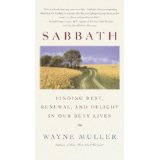“All lif e requires a rhythm of rest. There is a rhythm in our waking activity and the body’s need for sleep. There is a rhythminthe way day dissolves into night, and night into morning. There is a rhythm as the active growth of spring and summer is quieted by the necessary dormancy of fall and winter. There is a tidal rhythm, a deep eternal conversation between the land and the great sea. In our bodies, the heart perceptibly rests after each life-giving beat; the lungs rest between the inhale and the exhale.”
e requires a rhythm of rest. There is a rhythm in our waking activity and the body’s need for sleep. There is a rhythminthe way day dissolves into night, and night into morning. There is a rhythm as the active growth of spring and summer is quieted by the necessary dormancy of fall and winter. There is a tidal rhythm, a deep eternal conversation between the land and the great sea. In our bodies, the heart perceptibly rests after each life-giving beat; the lungs rest between the inhale and the exhale.”
“We have lost this essential rhythm. Our culture invariably supposes that action and accomplishment are better than rest, that doing something – anything—is better than doing nothing.”
“If we do not allow for a rhythm of rest, illness becomes our Sabbath.”
From Sabbath by Wayne Mueller
Yin Yoga
Yin is the stable, unmoving, hidden aspect of things; yang is the changing, moving, revealing aspect.
Yang: sun, day, summer, warm, active, light, masculine
Yin: moon, night, winter, cool, passive, dark, feminine
Yin yoga is a complement or balance to a more active practice. Deeper, longer, cooler, darker, quieter, getting into the connective tissues of the body, the subtle body and nervous system. But in Yin we are still stretching, allowing the connective tissues to elongate and strengthen. Creating space in the body. Using gravity to open the body and release. The two principles that differentiate yin practice from more yang approaches are: Longer holds in the poses (time); and Deep stretching of the connective tissues, relaxing the outer muscle tissues (gravity).
These longer, deeper poses allow the mind to quiet and find stillness within the pose.
II.46 Stiram Sukham Asanam. Abiding in ease is asana. Yoga is the ability to be still.
“Find repose in every pose.” B.K.S. Iyengar
Sherry teaches yin yoga, weaving her knowledge of yoga philosophy with the supported poses toe create a rich contemplative practice.
Grilley, Paul, Yin Yoga, White Cloud Press, Ashland, OR, 2002. Also: www.yogajournal.com/practice/580.
Restorative Yoga
Restorative yoga, as defined by Judith Lasater, is the intentional manipulation of the nervous system and use of props to facilitate deep relaxation, to induce a parasympathetic nervous system response.

Unlike Yin Yoga, Restorative is not stretching. Stretching is activating, stimulating, and irritating to the nervous system.
Restorative yoga, is intentionally stilling, quieting, calming, deactiviating the sympathetic nervous system.
Restorative yoga uses many props and supports as well as blankets and comforts to allow the body and mind to enter into full state of rest.
Yes! There is a person in there! Human Swaddling.
I.2 Yogas Chitta Vritti Nirodah. Yoga is the intentional calming and quieting of the modifications of the mind, the thoughts, patterns and tendencies in our individual field of consciousness.
Sherry has been certified to teach restorative yoga by acclaimed teacher, Judith Hanson Lasater.
Lasater, Judith Hanson, Relax and Renew: Restful Yoga for Stressful Times, Rodmell Press, Berkeley CA, 2011.

